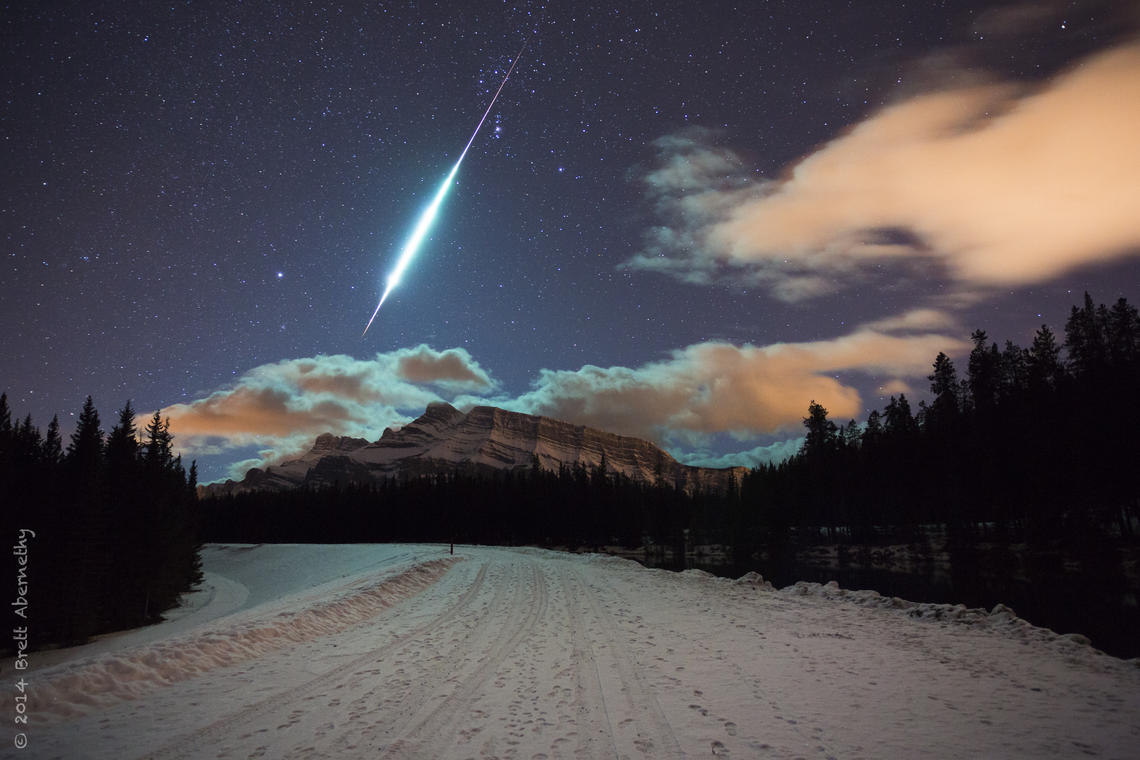Jan. 23, 2015
Hunt underway for rare rock after spectacular meteorite lands in B.C.

Satellite image of eastern British Columbia showing the location of the fireball trajectory.
Figure constructed on Google Earth base
In the month since a spectacular fireball descended over the Rocky Mountains and University of Calgary, researcher Alan Hildebrand has found himself on a quest for rare meteorites.
In the early morning hours of Dec. 20, a small piece of an asteroid entered Earth’s atmosphere high above Canal Flats, British Columbia, headed northeast toward Calgary. Although the western B.C. and eastern Alberta skies were overcast, the fireball was seen and imaged over the region in both provinces.
In his search for more information, Hildebrand contacted Brett Abernethy, the photographer who captured the initial image of the fireball near Banff. He also reached out to Rick Nowell at the College of the Rockies in Cranbrook, B.C. Nowell recorded the event with his all-sky video camera through patchy clouds and was able to correctly mark the fireball’s start time to precisely 00:25:00. With this detail, another all-sky still image was obtained from the University of Calgary’s Rothney Astrophysical Observatory and Hildebrand and his team were able to triangulate the fireball’s location in the sky.

Brett Abernethy’s image of the Dec 20, 2014 fireball looking south over Mt. Rundle near Johnson Lake
Brett Abernethy. All rights reserved.
Fireball became visible 100 kilometres above Earth
“In the photo taken by Brett, the fireball becomes visible at approximately 100 kilometres altitude, starts fragmenting at approximately 60 km, and has its last and biggest explosion at 43 km. Those altitudes are much higher than normal; that means the rock was likely a weak type of asteroid — it shows extraordinary properties,” says Hildebrand, an associate professor in the Department of Geoscience.
“It was very interesting to see how precisely a fireball path could be located just from two pictures taken more than 100 km away. We probably know where it was, start to finish within 100 metres,” says Lincoln Hanton, a recent University of Calgary graduate working with Hildebrand. The video recorded in Cranbrook and the fireball’s trajectory also shows that it entered the Earth’s atmosphere slowly, which favours the fall of meteorites.
Hildebrand says the apparent weakness displayed indicates this rock was unusual, probably a carbonaceous chondrite, which is a specific type of stony meteorite that originates from the Outer Asteroid Belt. At that distance from the sun, water and carbon-bearing compounds condensed and mixed into asteroidal bodies. Carbonaceous chondrites represent approximately three per cent of meteorites that fall on Earth.
Property owners in the area encouraged to look for clues
Hildebrand and his team are eager to talk with anyone from Canal Flats, Fairmont Hot Springs, or Elkford, B.C. who saw the fireball. He encourages property owners in the area to check security camera systems for any shadows cast by the fireball. Anyone who had a wildlife camera is also asked to check that date and time for moving shadows. Contact the University of Calgary at 403-220-8969 or via email at ltjhanto@ucalgary.ca.
